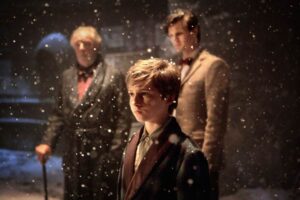Moffat’s Best Monsters, Tricks & Stories (So Far)
Mark McCullough celebrates the best of Steven Moffat so far.
If The Day of the Doctor taught us nothing else, we know that Steven Moffat can throw a good birthday party. It would be my hope that someone would return the favour and give Moffat a birthday to remember. Perhaps a worldwide cinema showing of Moffat’s Darkest Day would not be appropriate (although I’m sure it would be riveting entertainment). Instead the best way to celebrate Moffat is to celebrate he has given us so far. So without further ado, here is my compilation of Moffat’s greats. And if by some miracle he is reading this, I wish the man himself a wonderful day, and many more happy birthdays to come. (Hopefully a few more cracker episodes delivered from his pen too).
Top 5 Moffat Monsters
Most of Moffat’s monsters are certainly memorable (the Silence may want a word with me for saying that). It is quite apparent that he enjoys using things which are already established as fundamental human fears. Because of this his monsters have that added bite that helps them step out from under the shadows of pre-established ones. They can send stone cold shivers down your spine, take your breath away, and leave you questioning if they even exist. He can make you scared of the ordinary, like a child looking its mother, or scare you with nothing at all. So which creatures make the list of his top five?
5. The Empty Child

Coming in fifth place is the Empty Child, not a conventional monster as per se, rather a young boy who died and was resurrected by alien nano-genes. The creature’s goal was simple yet chilling, to find his mum. A lonely young boy capable of immense destruction in a way he can’t control. One touch and you become like him, an utterly terrifying prospect.
4. The Vashta Nerada
 Lots of people are scared of the dark; this is usually classed as an irrational fear, or a phobia. However Moffat would have you believe that it’s not irrational, it’s Vashta Nerada, invisible piranha like creatures who devour your flesh in a matter of seconds. Fear of the unseen, fear of the dark, and fear of death, this concept combines all three with an excellent effect.
Lots of people are scared of the dark; this is usually classed as an irrational fear, or a phobia. However Moffat would have you believe that it’s not irrational, it’s Vashta Nerada, invisible piranha like creatures who devour your flesh in a matter of seconds. Fear of the unseen, fear of the dark, and fear of death, this concept combines all three with an excellent effect.
3. Fear itself/ the Hiders
 It takes a lot of skill to write a good monster, Moffat undisputedly has this. It takes even more skill to write a great monster, which has fans arguing over whether it really existed. That’s what Moffat manages in Listen where he shows up a gripping premise of the effects of a proposed monster without ever actually showing it. Furthermore each of the occurrences could be explained in another way, leaving the very existence of the Hiders ambiguous. Question: What’s that in the corner of your eye? What’s that footstep coming close but never passing by? Answer: Moffat doing what he is best at.
It takes a lot of skill to write a good monster, Moffat undisputedly has this. It takes even more skill to write a great monster, which has fans arguing over whether it really existed. That’s what Moffat manages in Listen where he shows up a gripping premise of the effects of a proposed monster without ever actually showing it. Furthermore each of the occurrences could be explained in another way, leaving the very existence of the Hiders ambiguous. Question: What’s that in the corner of your eye? What’s that footstep coming close but never passing by? Answer: Moffat doing what he is best at.
2. The Weeping Angels

The Weeping Angels, possibly Moffat’s defining monster and the creatures that can only move when you aren’t looking at them. When they do get the chance, they move at lightning pace meaning there is no escaping their grasp. How they attack is only the start of our troubles, it’s the manner of the attack that is particularly frightening, they send you back in time so you will never see anyone who you cared about again. The Angels are a collection of scary concepts which fit together perfectly.
1. The Silence
 What is there to say about the Silence other than that they are my favourite monsters of all time and are easily the best idea brought to life by Moffat’s pen? What is so good about them? Like the Angels and the Vashta Nerada, they play on the fear of the unseen, but that’s not the complete story. The Silence can in fact be seen, it’s just that the person forgets everything about the encounter and that’s where the fun comes in. Schrödinger theorised that you cannot be certain that something exists unless you actively observe it. So there very well could be a Silent controlling Moffat to write the stories we have seen.
What is there to say about the Silence other than that they are my favourite monsters of all time and are easily the best idea brought to life by Moffat’s pen? What is so good about them? Like the Angels and the Vashta Nerada, they play on the fear of the unseen, but that’s not the complete story. The Silence can in fact be seen, it’s just that the person forgets everything about the encounter and that’s where the fun comes in. Schrödinger theorised that you cannot be certain that something exists unless you actively observe it. So there very well could be a Silent controlling Moffat to write the stories we have seen.
Top 5 Moffat Tricks
There was an affectionate term coined on this very site which aptly describes these types of situation. That phrase is ‘Pulling a Moffat’ (credit to Chris) and no that is not a strange nightclub game, it is a description of a narrative technique where the audience are misled and end up missing the obvious answer. Obviously given we have named the technique after him, Moffat is the master at pulling a Moffat. Here’s his five best:
5. “The only water in the forest is the river”

This one was the obvious connection between Melody Pond and River Song, the reversal of the name order and substitution of the words played a large part in the reveal.
4. “Missy, short for Mistress”

Everyone was trying to anticipate the identity of Missy by looking into the tiny details of her character. As it transpired the actual solution was dismissed early on by the fandom for being too obvious by Moffat’s standards.
3. “The Doctor has a secret he will take to the grave. It is discovered”

This time Moffat played with sentence syntax in order to pull the wool over our eyes. The logical assumption from the sentence is that the secret has been discovered when it fact Moffat meant it to be the grave.
2. “The Doctor in a Doctor suit”

The Teselecta twist from The Wedding of River Song is a wee bit divisive to say the least. Despite this there is no denying that it is an incredibly clever way out of the near impossible situation and was one which had been established well in advance of its use here.
1. Two Heads
The Weeping Angels two parter featured Moffat’s greatest illusion. Much like a magician he achieves his trick by distraction; the narrative is so tense that no one is counting the number of heads on the statues. Not on first viewing any way. I can’t watch it without stopping to think, you clever man.
Six Super Steven Stories
For this section of the article I’ve decided to shake things up a bit. I’m not going to rate the episodes against each other, because that will take the focus off the praise of the episodes themselves. Secondly since opinions are very subjective and I know I would leave off episodes that others would see as a crime not to include, I have drafted in the help of two other writers to present a fairer selection of episodes. So Ed Goundrey-Smith and Simon Roberts have offered their thoughts on two episodes each, along with my two.
The Day of the Doctor (Mark)

Listen (Mark)

A Christmas Carol (Simon)

The Time of the Doctor (Simon)

The Girl in the Fireplace (Ed)

The Eleventh Hour (Ed)

Conclusion
Moffat has given us so much fantastic Who over the course of his tenure, and there is probably so much more still to come. I’ve seen him called many things: the greatest writer the show has had, the master troll, or rather strangely ‘Moffaf’ (you know who you are ;P). But I’m sure one thing we can all agree on is that he deserves thanks for all he has given. So let’s come together to wish him a very happy birthday.
List your own favourites in the comments below!









